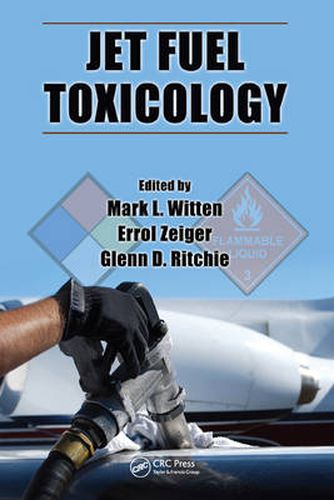Readings Newsletter
Become a Readings Member to make your shopping experience even easier.
Sign in or sign up for free!
You’re not far away from qualifying for FREE standard shipping within Australia
You’ve qualified for FREE standard shipping within Australia
The cart is loading…






Currently serving as a resource for the National Center for Toxological Research in their work with the Gulf Coast oil spill, this book presents current research conducted primarily by the airforce on the toxic effects of JP-8 jet fuel on the pulmonary, immune, dermal, and nervous systems. In all, the book considers 13 toxicology studies of significance, the results of which are currently shaping US armed services policy. It will enable all of the hydrocarbon industry to make better choices regarding fuel handling. Due to its widespread use, jet fuel is thought to be the largest toxicant exposure risk for U.S. Armed Services personnel. Taking a proactive approach to the potential dangers of repeated human exposure to hydrocarbon fuels, the Air Force Office of Scientific Research (AFOSR) sponsored a number of research projects during the last 20 years investigating health effects resulting from specific exposure to JP-8 (Jet Propellant-8). Jet Fuel Toxicology summarizes the newest and most important results of these extensive research programs carried out by hydrocarbon fuel research groups throughout the U.S. Each book chapter highlights one specific research area from the many topical areas comprising jet fuel toxicology. After examining the contents and general action of JP-8, the book looks at how the fuel affects various body functions highlighted by: Effects on daily inhalation on the respiratory system Acute and long-term neurotoxicological and neurobehavioral effects Both local and systemic toxicity following exposure through the skin Immunotoxicity from pulmonary and dermal exposures Genetic damage, as evidenced in studies of the blood and bone marrow of mice In all, the book considers 13 major toxicology areas of study, the results of which will enable all of the hydrocarbon industry to make fuel choices that more carefully consider possible human health risks. Perhaps even more importantly, the book profoundly demonstrates how unfortunate lessons from the following major chemical exposure scenarios of the past must not be lost in the ongoing protection of both military personnel and civilians: Agent Orange exposures during the Vietnam War Multiple chemical/stressor exposures, including multiple fuels and solvents, during the Persian Gulf Wars Chemical exposures, including Jet-A fuel, during the 9/11 World Trade Center Disaster Hydrocarbon/oil dispersing compound exposures during the Gulf of Mexico Oil Spill Crisis of 2010 For example, based on data contained in this book, the Air Force now removes female personnel from any exposure to jet fuel during their pregnancies and has reduced permissible exposure levels to jet fuel for all military and associated civilian staff. Ultimately, this book can serve as a template for managing future toxicological issues for both international armed forces and those corporations willing to learn from these important lessons.
$9.00 standard shipping within Australia
FREE standard shipping within Australia for orders over $100.00
Express & International shipping calculated at checkout
Currently serving as a resource for the National Center for Toxological Research in their work with the Gulf Coast oil spill, this book presents current research conducted primarily by the airforce on the toxic effects of JP-8 jet fuel on the pulmonary, immune, dermal, and nervous systems. In all, the book considers 13 toxicology studies of significance, the results of which are currently shaping US armed services policy. It will enable all of the hydrocarbon industry to make better choices regarding fuel handling. Due to its widespread use, jet fuel is thought to be the largest toxicant exposure risk for U.S. Armed Services personnel. Taking a proactive approach to the potential dangers of repeated human exposure to hydrocarbon fuels, the Air Force Office of Scientific Research (AFOSR) sponsored a number of research projects during the last 20 years investigating health effects resulting from specific exposure to JP-8 (Jet Propellant-8). Jet Fuel Toxicology summarizes the newest and most important results of these extensive research programs carried out by hydrocarbon fuel research groups throughout the U.S. Each book chapter highlights one specific research area from the many topical areas comprising jet fuel toxicology. After examining the contents and general action of JP-8, the book looks at how the fuel affects various body functions highlighted by: Effects on daily inhalation on the respiratory system Acute and long-term neurotoxicological and neurobehavioral effects Both local and systemic toxicity following exposure through the skin Immunotoxicity from pulmonary and dermal exposures Genetic damage, as evidenced in studies of the blood and bone marrow of mice In all, the book considers 13 major toxicology areas of study, the results of which will enable all of the hydrocarbon industry to make fuel choices that more carefully consider possible human health risks. Perhaps even more importantly, the book profoundly demonstrates how unfortunate lessons from the following major chemical exposure scenarios of the past must not be lost in the ongoing protection of both military personnel and civilians: Agent Orange exposures during the Vietnam War Multiple chemical/stressor exposures, including multiple fuels and solvents, during the Persian Gulf Wars Chemical exposures, including Jet-A fuel, during the 9/11 World Trade Center Disaster Hydrocarbon/oil dispersing compound exposures during the Gulf of Mexico Oil Spill Crisis of 2010 For example, based on data contained in this book, the Air Force now removes female personnel from any exposure to jet fuel during their pregnancies and has reduced permissible exposure levels to jet fuel for all military and associated civilian staff. Ultimately, this book can serve as a template for managing future toxicological issues for both international armed forces and those corporations willing to learn from these important lessons.